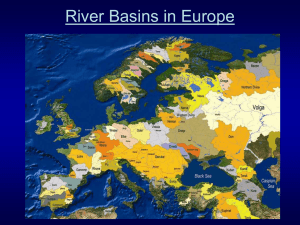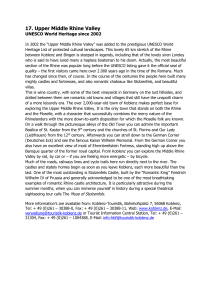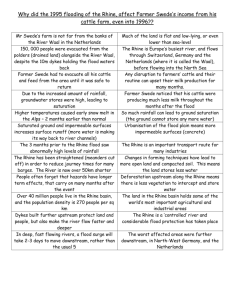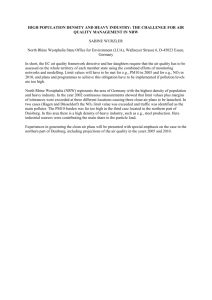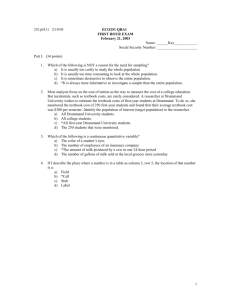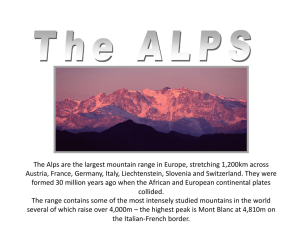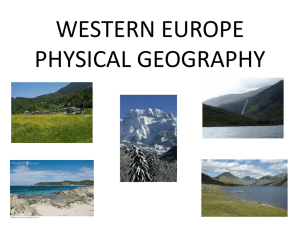INITIAL RESULTS ON THE TROPHIC RELATIONSHIPS BASED COROPHIUM CURVISPINUM STABLE ISOTOPES F.
advertisement
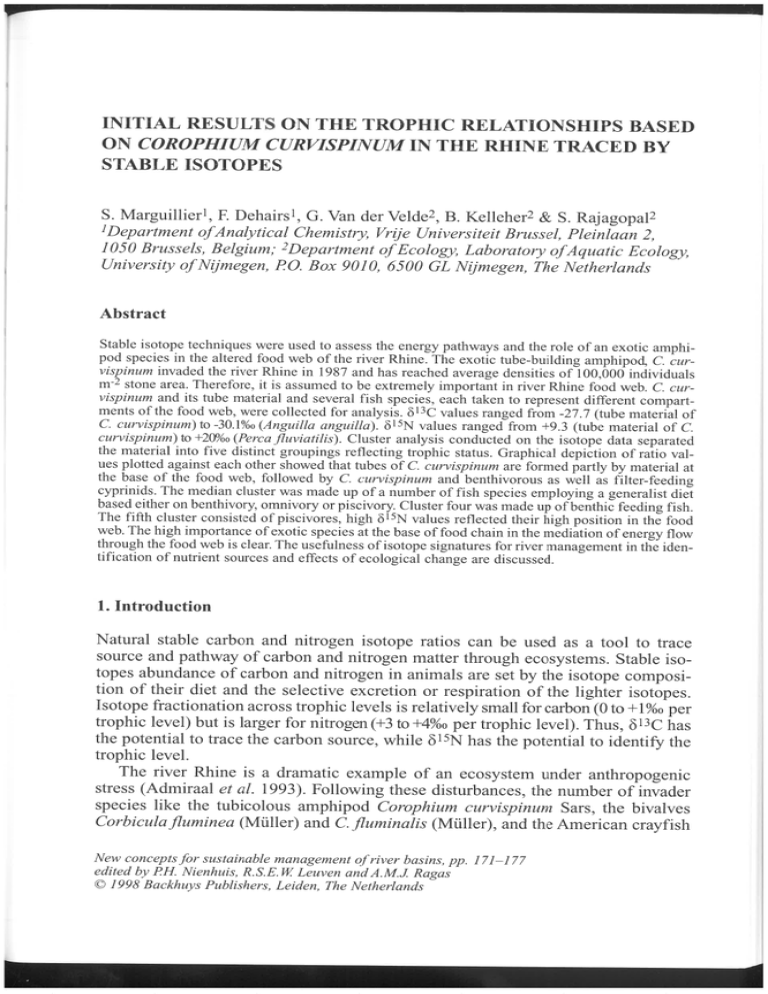
INITIAL RESULTS ON THE TROPHIC RELATIONSHIPS BASED ON COROPHIUM CURVISPINUM IN THE RHINE TRACED BY STABLE ISOTOPES S. Marguillierl, F. Dehairsl, G. Van der Velde2, B. Kelleher2 & S. Rajagopal2 'Department ofAnalytica1 Chemistry, Vrije Universiteit Brussel, Pleinlaan 2, 1050 Brussels, Belgium; 2Department of Ecology, Laboratory ofAquatic Ecology, University of Nymegen, PO. Box 901 0, 6500 GL Nijmegen, The Netherlands Abstract Stable isotope techniques were used to assess the energy pathways and the role of an exotic amphipod species in the altered food web of the river Rhine. The exotic tube-building amphipod, C. curvispinum invaded the river Rhine in 1987 and has reached average densities of 100,000 individuals m-2 stone area. Therefore, it is assumed to be extremely important in river Rhine food web. C. curvispinum and its tube material and several fish species, each taken to represent different compartments of the food web, were collected for analysis. 613C values ranged from -27.7 (tube material of C. cuwispinum) to -30.1%0(Anguilla anguilla). FISN values ranged from +9.3 (tube material of C. cuwispinum) to +20°?0(Percajltwiatilis). Cluster analysis conducted on the isotope data separated the material into five distinct groupings reflecting trophic status. Graphical depiction of ratio values plotted against each other showed that tubes of C. cuwispinum are formed partly by material at the base of the food web, followed by C. cuwispinum and benthivorous as well as filter-feeding cyprinids. The median cluster was made up of a number of fish species employing a generalist diet based either on benthivory, omnivory or piscivory. Cluster four was made up of benthic feeding fish. The fifth cluster consisted of piscivores, high 615N values reflected their high position in the food web. The high importance of exotic species at the base of food chain in the mediation of energy flow through the food web is clear. The usefulness of isotope signatures for river management in the identification of nutrient sources and effects of ecological change are discussed. 1. Introduction Natural stable carbon and nitrogen isotope ratios can be used as a tool to trace source and pathway of carbon and nitrogen matter through ecosystems. Stable isotopes abundance of carbon and nitrogen in animals are set by the isotope composition of their diet and the selective excretion or respiration of the lighter isotopes. Isotope fractionation across trophic levels is relatively small for carbon (0 to +1%0per trophic level) but is larger for nitrogen (+3 to +4%0per trophic level). Thus, 613C has the potential to trace the carbon source, while 615N has the potential to identify the trophic level. The river Rhine is a dramatic example of an ecosystem under anthropogenic stress (Admiraal et al. 1993). Following these disturbances, the number of invader species like the tubicolous amphipod Corophium cuwispinum Sars, the bivalves Corbiculafluminea (Muller) and C. fluminalis (Muller), and the American crayfish New concepts for sustainable management ofriver basins, pp. 171-1 77 edited by l?H. Nienhuis, R.S.E. n!Leuven andA.M.J Ragas O 1998 Backhuys Publishers, Leiden, The Netherlands 172 S. Mavguilliev et al. Orconectes limosus (Rafinesque) in the Rhine has increased and they have occupied niches left empty by the decline of native macrozoobenthos (Den Hartog et al. 1992). In 1987, C. cuwispinum was first observed in the Lower Rhine, the Netherlands (Van den Brink et al. 1989). The maximum density (750,000 individuals m-2) of C. cuwispinum in the Lower Rhine is one of the highest ever reported in the literature (Van den Brink et al. 1993). By virtue of its high densities and construction of tubes nearly all stones are covered by a 1-4 cm layer (38-1044 g m-2 dry weight of muddy material including macroinvertebrates). The percentage of organic matter in this mud layer, including macroinvertebrates ranged from 9% to 23% with the mean value of 16% (Van der Velde et al. 1994). As a filter feeder, its high densities are thought resposible for decline in the amount of total organic carbon and suspended matter since its invasion (Van den Brink et al. 1993). The objective of this study is to identify the present role of the invading amphipod C. cuwispinum in the food web dynamics of the river Rhine by means of stable carbon and nitrogen isotope ratios of different fish species and C. cuwispinum and its tube material. 2. Materials and methods 2.1. Sampling sites Materials for stable isotope analysis were collected from the main channel of the Rhine branches IJssel and Waal in the Netherlands during 1994. 2.1.1. Fish Fish were collected with electrofishing equipment and stored on ice during transport to the laboratory. Subsequently, each specimen's total length was measured and its total weight was recorded to the nearest gram using an electronic balance. Only muscle tissue, carefully excised from each specimen with a clean scalpel, was used for the analysis of isotopic composition. This is because the slow turnover rate of muscle results in integrating diet effects over months, and thus allows the exclusion of short-term variability effects (Gearing 1991). Samples were wrapped individually and freeze-dried for 24 hours. 2.1.2. C. cuwispinum and tube material Eleven samples (10 x 10 cm quadrates) of sediment fixed to groyne stones on the breakwater were taken. Materials were transported to the laboratory and subsequently deep-frozen (-20°C). C. cuwispinum and its tube material were removed from the thawed material. Specimens of C. cuwispinum in the water column were also collected with a hand held drift net (mouth diameter: 30 cm; depth: 1 m; mesh: 1 mm; handle length: 1.8 m). The net's position in the stream was maintained by suspending a 1 kg weight from its circular mouth. Collected specimens of C. curvispinum were freeze-dried for 24 hours. Tube material was dried at 60°C for several hours and then ground to a fine powder using a pestle and mortar. Initial results on the trophic relationships based on Corophium czlrvispinum in the Rhine 173 2.2. Isotopic analysis Mass spectrometric measurements were performed using a Delta E, Finnigan Mat isotope ratio mass spectrometer. For carbon isotopic ratios, the organic material was combusted in an Elemental Analyzer (Carlo Erba NA 1500). The C 0 2 generated during the combustion was automatically trapped in an on-line Finnigan Mat trapping box for cryopurification before injection into the mass spectrometer. For the nitrogen isotopic ratios, the N2 gas produced during combustion was cryogenically trapped in stainless steel tubes fitted with a molecular sieve, and samples were manually introduced into the mass spectrometer. A graphite reference material (USG24) was used as a standard for carbon isotopic ratio measurement. Values are expressed relative to the VPDB (Vienna Peedee Belemnite) standard (Coplen, 1996). High-purity tank nitrogen gas was used as working standard for nitrogen isotope. This working standard was calibrated against NI and N2 ammonium sulphate (IAEA, Vienna). 615N values are reported relative to nitrogen in air. Stable carbon and nitrogen isotopic ratios are presented as d values. where R = 13C or 15N and X = 13CIl2C or l5NIl4N Reproducibility for the analysis of different aliquots of the same tissue sample was generally better than 0.2%0for both isotopes. 3. Results Cluster analysis (Statistica version 5) was conducted on the data of 613C and @5N from fish, C. cuwispinum and its tube material. The species type and total length of each fish analyzed is given in Table 1. For a cluster analysis of the results, euclidean distances and complete linkage were chosen (Fig. 1). Five clusters were selected by setting an arbitrarily linkage distance of four. The 613C values of the measured samples ranged from -24.7%0(tube material of C. cuwispinum) to -30.1 %O(Anguilla anguilla) and 615N values ranged from +9.3%0 (tube material of C. cuwispinum) to +20%0(PercaJluviatilis). Cluster 1, with the lowest range in 615N (from +9.3 to 12.7%0)was made up of tube material from C. cuwispinum (613C = -24.7 to -27.6 %o).This material consists of mud filtered out of the water column and excretory products from the amphipod. In the second cluster (range 615N = 13.7 to 16.0%0; 613C = -27.2 to -28.6%0), C. cuwispinum was grouped together with the benthic feeder Abramis brama and also with Rutilus rutilus. R. rutilus can feed on a variety of food items but individual specimens can more or less specialise on molluscs, crustaceans, algae and detritus. Cluster three (range 615N = 16.5 to 19.2%0;613C= -25.7 to -28.6%0)had a more diverse array of feeding guilds, consisting of benthic feeders, omnivores and piscivores, represented by Pleuronectes Jesus, R. rutilus, A. anguilla and P Juviatilis, respectively. Cluster four (range 615N = 16.5 to 18.3%0;613C = -27.9 to -30.1%0)consisted of benthic feeders, represented by A. anguilla, Gobio gobio and P j e s u s . Finally, cluster five (range 615N = 19.8 to 20.0%0;613C = -27.8 to -29.0%0)with the highest values in 615N was made up of piscivorous PJluviatilis, the top predator (Fig. 2). S. Mavguilliev et al. 174 Linkage Distance 0 1 2 4 5 3 I P.jluvatilis 6 1 P.$uviatilis 7 A.anguilla 8 G.gobio 9 G.gobio I0 P.jlesus I1 R. rutilus I2 A.anguilla 13 A.anguilla 14 A.anguilla 15 A.anguilla 16 P.jlesus 17 P.$uviatilis 18 P.jluviatilis 19 R. rutilus 20 Rrutilus 21 R.nuilus22 R. rutilus 23 R.rutilus 24 R.nUilus 25 6 7 8 9101112 l l I I I I 5 I Fig. I. Cluster analyses on 613C and 615N data by euclidean distances and complete linkage from fishes, C.cuwispinum and its tube material in the rivers Waal and IJssel. Initial results on the tvophic relationships based on Corophit~mcuwispinunz in the Rhine 175 Table I . Total length of fish specimens shown in Figure 1. - - - -- - - - - River Waal - Fish species Sample number in Fig.1 Total length (cm) Fish species Sample number in Fig.1 Rutilus rutilus (L.) 4 2 12 23 3 24 5 1 29 26 20 20 19 14 19 17 Rutilus rutilus (L.) 25 21 20 11 17 15 13 Abramis brama L. - - River IJssel Pleuronectes Jesus (L.) Anguilla anguilla (L.) Total length (cm) Gobio gobio (L.) Perca Jluviatilis L. 18 19 7 6 18 18 9 9 + R.rutitus-W A.brama-W A R.mtilus-Y X P.fTesus-Y * A.anguilla-Y G.gobio + P.fluviatilis - C.curvispinwn - tube material -24 Fig. 2. 613C versus 6l5N values from fishes, C. curvispinum and its tube material in the rivers Waal (W) and IJssel (Y). 1 - 5 indicate the clusters obtained from the cluster analysis as shown in Fig. 1. 176 S. Mavguilliev et al. 4. Discussion and conclusion The isotope techniques give information which is useful in the understanding of ecological processes operating within the Rhine. The 613C range of this food web (fi-om -24.7 to -30.1%0) coincides with the 613C range of the C3 plants (-24 to -30%0; Fry & Sherr 1984), indicating that the organic carbon pool in the Rhine is derived to a large extent from terrestrial organic carbon. Furthermore, this particular food web is characterised by high 615N values. C. cuwispinum tube material, which can be taken to reflect the suspended matter, and thus a lower trophic level, already shows quite positive 615N values (up to +12.7%0).615N values of C. curvispinum appeared to be intermediate between their potential fish predators and their tube material, indicating that C. cuwispinum forms the food base of the fish assemblage. Another study, in which stomach contents are examined, will assess how far fish species have made a diet shift towards C. cuwispinum after its invasion (Kelleher et al. 1998). The diet shift study and present study identify C. cuwispinum as an important resource for consumers in the Rhine food web, and clearly show that a significant amount of energy flows through this non-native component. The highest 615N value for fish (+20%0for Percafluviatilis) exceeds the values generally observed for other piscivores in other ecosystems (Hobson & Welch 1992; Rau et al. 1992; Newel1 et al. 1995; Marguillier et al. 1997) i.e. PercaJlavescens (Mitchill) (12%0) (Cabana & Rasmussen 1996). The observed high 615N values for the Rhine may be the result of the significant anthropogenic influence over the river's nitrogen input, for example, due to enhanced mineralisation of soil organic matter through agricultural practices (like using fertilizers) and disposal of animal or sewage wastes (Macko & Ostrom 1994; Cabana & Rasmussen 1996). Cabana & Rasmussen (1996) present data on 615N contents of primary consumers related to increased human population densities in water sheds. They reported a enrichment of 8%o615N at the highest population densities. This is in accordance with the very high 615N values found in the river Rhine. The observed 613C and 615N values are some of the highest ever reported in an aquatic ecosystem and stongly indicate that the Rhine's carbon pool is largely derived from terrestrial sources and a significant input of nitrogen by anthropogenic sources. The results of this study show that measuring 615N signatures at the base of food chain can provide useful tool in the assessment of human nutrient inputs which has been identified as an important contributor to the nitrogen budget of a aquatic system (Cabana & Rasmussen 1996). Acknowledgements We thank Prof. Dr. E. Keppens for access to mass spectrometer facilities. We also thank F. Koomen, PH. van Avesaath and M.G. Versteeg for collection of samples. Help rendered during the laboratory work by M.J.E. Orbons, is greatly acknowledged. References Admiraal, W., Van der Velde, G., Smit, H. & Cazemier, W.G. 1993. The rivers Rhine and Meuse in The Netherlands: present state and signs of ecological recovery. Hydrobiologia 295: 97-128. Initial results on the trophic relationships based on Corophium ctrwispinum in the Rhine 177 Cabana, G. & Rasmussen, J.B. 1996. Comparison of aquatic food chains using nitrogen isotopes. Proc. Natl. Acad. Sci. USA 93: 10844-10847. Coplen, T.B. 1996. New guide lines for reporting stable hydrogen, carbon, and oxygen isotope-ratio data. Geochim. Cosmochim. Acta 60: 3359-3360. Den Hartog, C., Van den Brink, F.W.B. &Van der Velde, G. 1992. Why was the invasion of the river Rhine by Corophium curvispinum and Corbicula species so successful?. J. Nat. Hist. 26: 11211129. Fry, B. & Sherr, E.B. 1984. 613C measurements as indicators of carbon flow in marine and freshwater ecosystems. Contrib. Mar. Biol. 27: 13-47. Gearing, J.N. 1991. The study of diet and trophic relationships through natural abundance 13C. In: Coleman, D.C. & Fry, B. (eds), Carbon isotope techniques. pp. 201-218. Academic Press, London, UK. Hobson, K.A. &Welch, H.E. 1992. Determination of trophic relationship within a high Artic marine food web using 6l3C and 615N analysis. Mar. Ecol. Prog. Ser. 84: 9-18. Kelleher, B., Bergers, P.J.M., Van den Brink, F.W.B., Giller, PS., Van der Velde, G. & Bij de Vaate, A. 1998. Effects of exotic amphipod invasions on fish diet in the Lower Rhine. Arch. Hydrobiol. (Accepted). Macko, S.A. & Ostrom, N.E. 1994. Pollution studies using stable isotopes. In: Lajtha, K. & Michener, R.H. (eds), Stable isotopes in ecology and environmental science. pp. 45-62. Blackwell Science Inc., Oxford, UK. Marguillier, S., Van der Velde, G., Dehairs, F., Hemminga, M.A. & Rajagopal, S. 1997. Trophic relationships in an interlinked mangrove seagrass ecosystem as traced by 613C and 615N. Mar. Ecol. Prog. Ser. 151: 115-121. Newell, R.I.E., Marshall, N., Sasekumar, A. & Chong, VC. 1995. Relative importance of benthic microalgae, phytoplankton, and mangroves as sources of nutrition for penaeid prawns and other coastal invertebrates from Malaysia. Mar. Biol. 123: 595-606. Rau, G., Ainley, D.G., Bengtson, J.L., Torres, J.J. & Hopkins, T.L. 1992. l5NI14N and l3C112C in Weddell sea birds, seals, and fish: implications for diet and trophic structure. Mar. Ecol. Prog. Ser. 84: 1-8. Van den Brink, F.W.B., Van der Velde, G. & Bij de Vaate, A. 1989. A note on the immigration of Corophium cuwispinum Sars, 1895 (Crustacea: Amphipoda) into The Netherlands via the River Rhine. Bull. 2001. Museum Univ. Amsterdam 11: 2 11-213. Van den Brink, F.W.B., Van der Velde, G. & Bij de Vaate, A. 1993. Ecological aspects, explosive range extension and impact of a mass invader, Corophium cuwispinum Sars, 1895 (Crustacea: Amphipoda), in the lower Rhine (The Netherlands). Oecologia 93: 224-232. Van der Velde, G., Paffen, B.G.P., Van den Brink, F.W.B., Bij de Vaate, A. & Jenner, H.A. 1994. Decline of Zebra mussel populations in the Rhine. Competition between two mass invaders (Dreissena polymorpha and Corophium cuwispinum). Naturwissenschaften 81: 32-34.
